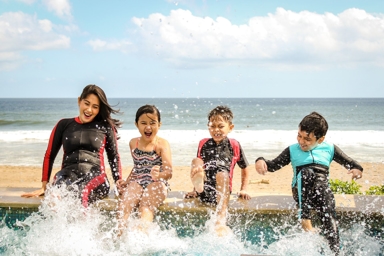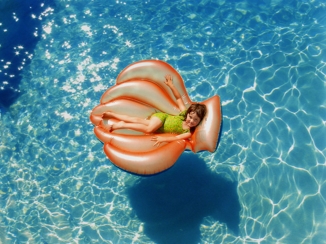 It’s not every day that residents of the Pacific Northwest get to cannonball into a body of water without turning into a glacial ice cube, so when those precious months roll around that promise warm weather and refreshing water, there’s no time to waste! With school out and summer break in full swing, hitting the pools, lakes, and water parks is likely on every eager child’s mind. While taking a day to soak up the sun at the pool can produce some precious memories for the entire family, make sure you’re aware of necessary safety precautions, for both you and your children, before diving in.
It’s not every day that residents of the Pacific Northwest get to cannonball into a body of water without turning into a glacial ice cube, so when those precious months roll around that promise warm weather and refreshing water, there’s no time to waste! With school out and summer break in full swing, hitting the pools, lakes, and water parks is likely on every eager child’s mind. While taking a day to soak up the sun at the pool can produce some precious memories for the entire family, make sure you’re aware of necessary safety precautions, for both you and your children, before diving in.
Consider Health
Before committing to a full day of flamingo floats, lazy rivers and Marco Polo, make sure you cover the bases to ensure that you and your children stay as healthy as possible. For starters, sunscreen, sunscreen and more sunscreen. You’ve heard it before, but we’ll say it again—overexposure to sun can have both short-term and long-term negative effects, so be mindful. According to the Skin Cancer Foundation, you should be applying SPF 30 or higher on children (and yourself) on the entire body before even getting into a swimsuit. From there, re-apply every two hours. A good day outdoors can turn sour quickly if it’s followed-up with sun-poisoning or second-degree sunburns.
Parents, this warning is more for you: be mindful of Cryptosporidium. This nasty fecal parasite is the product of people (particularly children) who swim too soon after having suffered from diarrhea, and it predominately affects healthy adults. The result is diarrhea that can last up to three weeks, stomach cramps, dehydration, nausea, vomiting, fever and weight loss. Yikes. This parasite has a high tolerance for chlorine, and can survive in pools for up to a week. According to the CDC, the US has experienced a 13% spike in crypto outbreaks per year over time. To avoid spreading this nasty parasite, don’t let your kids swim in a public pool for at least two weeks after recovering from diarrhea. As far as reducing your chances of contracting it: try your best to avoid swallowing water in public pools. There’s also the option to purchase test strips that will check chlorine levels and the PH of the pool—this way, you can dive in with confidence that the public pool is up to standards with chemicals that can help fight these types of parasites and bacteria.
Consider Environment
If you’ll be opting for a water adventure outside of a man-made facility, be mindful of the environment that you’re choosing. For example: the bed of a lake, river or the sea won’t always provide solid footing, such as that of a pool. Certain areas may have drastic drops in depth, which can be dangerous for weak swimmers or children. To combat this, do your research on the area, and walk out with your kids before allowing them to take off.
The same goes for currents: certain areas of lakes, rivers and oceans may present undercurrents that can be hazardous. Undercurrents are streams of water that flow underneath the surface of water—think of them as small rivers within a larger body of water. While many undercurrents can be harmless, more severe undercurrents and riptides can pull a person far away from shore, and even sweep them underwater. While undercurrents should be avoided at all costs, there are tactics for escaping in the event that you get caught up in one: do you research on these tactics, as well as how to identify an undercurrent from shore.
Additionally, lakes and rivers can have rocks and stumps that can serve as major hazards if you or your children plan on jumping into water from a small cliff or even a dock. If the body of water is not a popular area for such activities, you’ll want to practice extreme caution and scope out the area. Landing on a stump or rock can cause life-threatening injuries.
 Consider Emergency Procedures
Consider Emergency Procedures
It’s important to know how to identify signs of a struggle before allowing your children to play independently in water. For starters, keep an eye out for the four ‘toos’: too cold, too tired, too much sun, or too far from safety. If you, as a parent, see any of these events starting to occur, remove your child from the water so that you can address the issue. Even a 30-minute break resting, eating and spending time in the shade can prepare your child for continued fun. If you feel in your gut that it’s time to call it a day and head home, don’t be afraid to stand by that feeling—there will be other days for swimming, even if you’re momentarily the ‘bad guy.’
In the event that accident does occur, it’s wise for both you and your children to know proper safety precautions to handle the situation. Do they know how to float on their back should they start to over-tire from swimming without a life-vest? Do you know how to perform CPR should a lifeguard be off duty? Do you and your children know how to handle an undercurrent? Take thirty minutes to talk through these precautions with your children, and even show them examples of how to handle these events in the water. Having a game plan for potential emergencies may seem like over-kill in the moment, but should an accident occur, it could be difference of saving a life or losing one.
Before heading out for the water this summer, make sure you’ve considered potential risks and safety measures associated with swimming pools, water parks, lakes, rivers and oceans. It can be easy to think that a fatal accident could never happen to you or your children, however the reality is that people, and especially toddlers, drown from water activities every year due to unforeseen accidents. While this certainly shouldn’t deter you from getting outdoors and making the most of the sunny weather, it should create a sense of responsibility to be aware and prepared.

